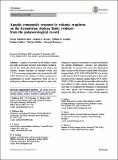Por favor, use este identificador para citar o enlazar a este item:
http://hdl.handle.net/10261/156352COMPARTIR / EXPORTAR:
 SHARE SHARE
 CORE
BASE CORE
BASE
|
|
| Visualizar otros formatos: MARC | Dublin Core | RDF | ORE | MODS | METS | DIDL | DATACITE | |

| Campo DC | Valor | Lengua/Idioma |
|---|---|---|
| dc.contributor.author | Matthews-Bird, Frazer | es_ES |
| dc.contributor.author | Brooks, Stephen John | es_ES |
| dc.contributor.author | Gosling, William D. | es_ES |
| dc.contributor.author | Gulliver, P. | es_ES |
| dc.contributor.author | Mothes, P. | es_ES |
| dc.contributor.author | Montoya, Encarnación | es_ES |
| dc.date.accessioned | 2017-10-17T10:06:48Z | - |
| dc.date.available | 2017-10-17T10:06:48Z | - |
| dc.date.issued | 2017-10 | - |
| dc.identifier.citation | Journal of Paleolimnology,58(4): 437–453 (2017) | es_ES |
| dc.identifier.issn | 0921-2728 | - |
| dc.identifier.uri | http://hdl.handle.net/10261/156352 | - |
| dc.description.abstract | Aquatic ecosystems in the tropical Andes are under increasing pressure from human modification of the landscape (deforestation and dams) and climatic change (increase of extreme events and 1.5 °C on average temperatures are projected for AD 2100). However, the resilience of these ecosystems to perturbations is poorly understood. Here we use a multi-proxy palaeoecological approach to assess the response of aquatic ecosystems to a major mechanism for natural disturbance, volcanic ash deposition. Specifically, we present data from two Neotropical lakes located on the eastern Andean flank of Ecuador. Laguna Pindo (1°27.132′S–78°04.847′W) is a tectonically formed closed basin surrounded by a dense mid-elevation forest, whereas Laguna Baños (0°19.328′S–78°09.175′W) is a glacially formed lake with an inflow and outflow in high Andean Páramo grasslands. In each lake we examined the dynamics of chironomids and other aquatic and semi-aquatic organisms to explore the effect of thick (> 5 cm) volcanic deposits on the aquatic communities in these two systems with different catchment features. In both lakes past volcanic ash deposition was evident from four large tephras dated to c.850 cal year BP (Pindo), and 4600, 3600 and 1500 cal year BP (Baños). Examination of the chironomid and aquatic assemblages before and after the ash depositions revealed no shift in composition at Pindo, but a major change at Baños occurred after the last event around 1500 cal year BP. Chironomids at Baños changed from an assemblage dominated by Pseudochironomus and Polypedilum nubifer-type to Cricotopus/Paratrichocladius type-II, and such a dominance lasted for approximately 380 years. We suggest that, despite potential changes in the water chemistry, the major effect on the chironomid community resulted from the thickness of the tephra being deposited, which acted to shallow the water body beyond a depth threshold. Changes in the aquatic flora and fauna at the base of the trophic chain can promote cascade effects that may deteriorate the ecosystem, especially when already influenced by human activities, such as deforestation and dams, which is frequent in the high Andes. | es_ES |
| dc.description.sponsorship | This study has been developed under the auspices of project FORSENS, funded by the Natural Environment Research Council UK (Grant NE/J018562/1 to E. Montoya). Radiocarbon dating was supported by the NERC Radiocarbon Facility NRCF010001 (allocation number 1682.1112) awarded to FORSENS project Permits for fieldwork in Ecuador were provided by the Ministry of Environment, Ecuador (14-2012-IC-FLO-DPAP-MA). | es_ES |
| dc.language.iso | eng | es_ES |
| dc.publisher | Springer Nature | es_ES |
| dc.relation.isversionof | Publisher's version | es_ES |
| dc.rights | openAccess | es_ES |
| dc.subject | Chironomids | es_ES |
| dc.subject | Lake sediment burial | es_ES |
| dc.subject | Long-term changes | es_ES |
| dc.subject | Non-pollen palynomorphs | es_ES |
| dc.subject | Sensitivity | es_ES |
| dc.subject | Tephras | es_ES |
| dc.title | Aquatic community response to volcanic eruptions on the Ecuadorian Andean flank: evidence from the palaeoecological record | es_ES |
| dc.type | artículo | es_ES |
| dc.identifier.doi | 10.1007/s10933-017-0001-0 | - |
| dc.description.peerreviewed | Peer reviewed | es_ES |
| dc.relation.publisherversion | http://dx.doi.org/10.1007/s10933-017-0001-0 | es_ES |
| dc.identifier.e-issn | 1573-0417 | - |
| dc.rights.license | http://creativecommons.org/licenses/by/4.0/ | es_ES |
| dc.contributor.funder | Natural Environment Research Council (UK) | es_ES |
| dc.contributor.funder | Ministerio de Educación (Ecuador) | es_ES |
| dc.relation.csic | Sí | es_ES |
| oprm.item.hasRevision | no ko 0 false | * |
| dc.identifier.funder | http://dx.doi.org/10.13039/501100000270 | es_ES |
| dc.identifier.pmid | 32009735 | - |
| dc.type.coar | http://purl.org/coar/resource_type/c_6501 | es_ES |
| item.fulltext | With Fulltext | - |
| item.languageiso639-1 | en | - |
| item.openairecristype | http://purl.org/coar/resource_type/c_18cf | - |
| item.openairetype | artículo | - |
| item.cerifentitytype | Publications | - |
| item.grantfulltext | open | - |
| Aparece en las colecciones: | (Geo3Bcn) Artículos | |
Ficheros en este ítem:
| Fichero | Descripción | Tamaño | Formato | |
|---|---|---|---|---|
| Montoya_Journal_of_paleolimnology_1.pdf | 1,62 MB | Adobe PDF |  Visualizar/Abrir |
CORE Recommender
PubMed Central
Citations
1
checked on 04-abr-2024
SCOPUSTM
Citations
13
checked on 24-abr-2024
WEB OF SCIENCETM
Citations
12
checked on 28-feb-2024
Page view(s)
309
checked on 24-abr-2024
Download(s)
254
checked on 24-abr-2024

